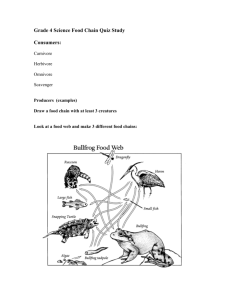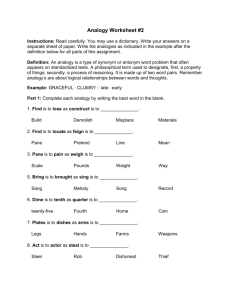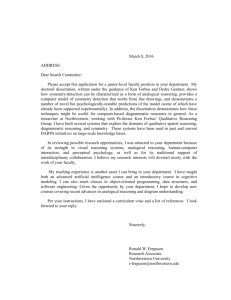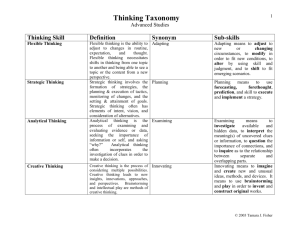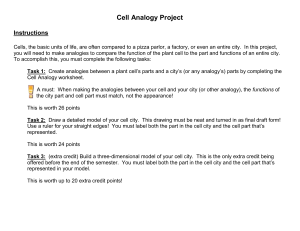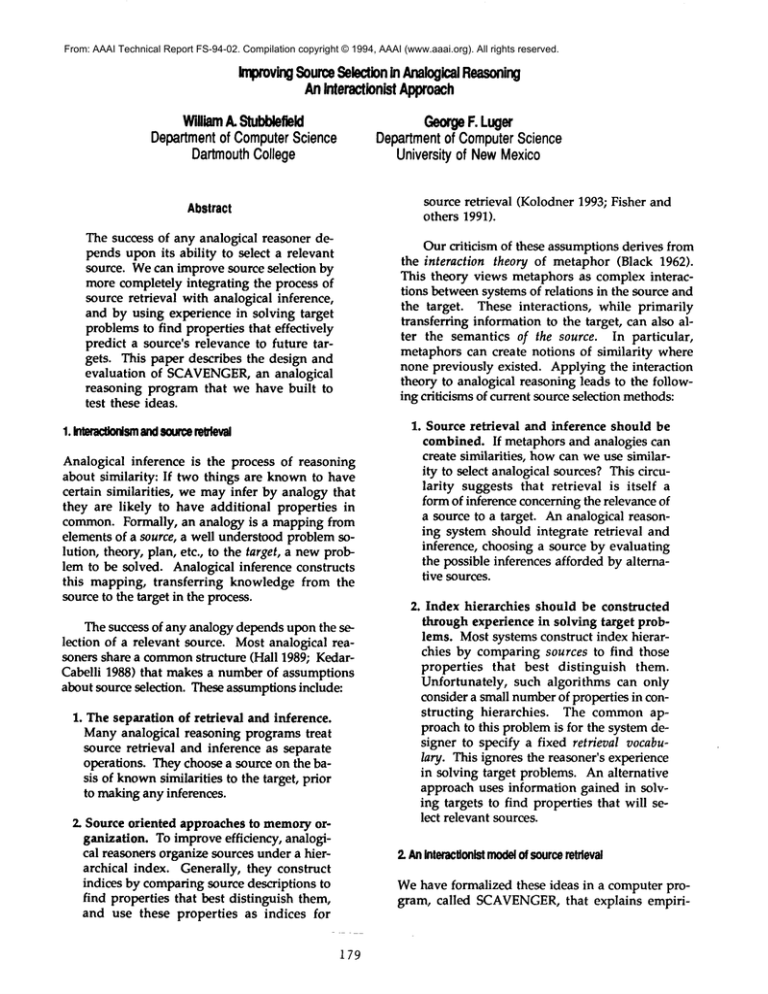
From: AAAI Technical Report FS-94-02. Compilation copyright © 1994, AAAI (www.aaai.org). All rights reserved.
Improving
Source
Selection
in Analogical
Reasoning
AnInleractionist
Approach
William
A.Stubblefield
Department
of Computer
Science
Dartmouth
College
George
F. Luger
Department
of Computer
Science
University
of New
Mexico
source retrieval
others 1991).
Abstract
The success of any analogical reasoner depends upon its ability to select a relevant
source. Wecan improve source selection by
more completely integrating the process of
source retrieval with analogical inference,
and by using experience in solving target
problems to find properties that effectively
predict a source’s relevance to future targets. This paper describes the design and
evaluation
of SCAVENGER,
an analogical
reasoning program that we have built to
test these ideas.
(Kolodner 1993; Fisher and
Our criticism of these assumptions derives from
the interaction
theory of metaphor (Black 1962).
This theory views metaphors as complex interactions between systems of relations in the source and
the target. These interactions,
while primarily
transferring information to the target, can also alter the semantics of the source. In particular,
metaphors can create notions of similarity
where
none previously existed. Applying the interaction
theory to analogical reasoning leads to the following criticisms of current source selection methods:
1. Inleractk~snlandsourceretdeval
Analogical inference is the process of reasoning
about similarity:
If two things are known to have
certain similarities,
we may infer by analogy that
they are likely to have additional properties in
common. Formally, an analogy is a mapping from
elements of a source, a well understood problem solution, theory, plan, etc., to the target, a new problem to be solved. Analogical inference constructs
this mapping, transferring
knowledge from the
source to the target in the process.
The success of any analogy depends upon the selection of a relevant source. Most analogical reasoners share a commonstructure (Hall 1989; KedarCabelli 1988) that makes a number of assumptions
about source selection. These assumptions include:
1. The separation of retrieval and inference.
Many analogical reasoning programs treat
source retrieval and inference as separate
operations. They choose a source on the basis of knownsimilarities to the target, prior
to making any inferences.
2. Source oriented approaches to memoryorganization. To improve efficiency, analogical reasoners organize sources under a hierarchical index. Generally, they construct
indices by comparing source descriptions to
find properties that best distinguish them,
and use these properties
as indices for
1. Source retrieval
and inference should be
combined. If metaphors and analogies can
create similarities,
how can we use similarity to select analogical sources? This circularity suggests that retrieval is itself a
form of inference concerning the relevance of
a source to a target. An analogical reasoning system should integrate retrieval
and
inference, choosing a source by evaluating
the possible inferences afforded by alternative sources.
2. Index hierarchies should be constructed
through experience in solving target problems. Most systems construct index hierarchies by comparing sources to find those
properties
that best distinguish
them.
Unfortunately,
such algorithms can only
consider a small number of properties in constructing
hierarchies.
The common approach to this problem is for the system designer to specify a fixed retrieval vocabulary. This ignores the reasoner’s experience
in solving target problems. An alternative
approach uses information gained in solving targets to find properties that will select relevant sources.
2. AnInteractionist
model
of source
retrieval
Wehave formalized these ideas in a computer program, called SCAVENGER,
that explains empiri-
179
cal observations through analogies with knowledge
of similar situations. Westate this problemas follows:
> (target-function-2
x)
b
Source objects and methods are stored along
with high-level descriptions of their semantics.
For example, the stack manipulation method, pop,
is stored in the source base with:
Given:
1. A series of observations to be explained.
These have a temporal order, but their
causal structure is not apparent.
1. Its argumentand result types:
pop: stack -> t
2. Knowledgeabout objects and processes in a
variety of domains. These are candidate
sources for explaining the observations.
2. Its LISPdefinition:
(defmethodpop ((s stack))...
3. Adescription of its result and side effects.
In this case, the result is an element of a
collection and the side-effect is to remove
an item from the collection passed in as its
first argument:
Goals:
1. Select an appropriate source, and construct
an analogy between it and the target observations.
result: (accessed-elementresult)
2. Based on this analogy, construct a causal
explanation of the observations.
side-effects:
((remove-from-collectionarg-0))
3. Confirm the explanation empirically.
Assumethat these experiments are costly,
and should be kept to a minimum.
Wehave represented observations to be explained as transcripts of evaluations of LISP functions. Sources are selected from a collection of
knownobjects and methods written in the Common
LISP Object System. Wechoose this representation
in order to test our ideas using a complexlanguage
that was not of our owndesign. Also, this representation enables the reasoner to test its inferences by
constructing and evaluating LISPfunction calls.
For example,consider the problemof explaining the meaningof target-class, target-function-1
and target-function-2 in the following transcript.
The transcript represents the behavior of these
functions as if they were evaluated by the LISP interpreter1:
To illustrate SCAVENGER’s
behavior, consider
the example of interpreting the above transcript.
Assumethat sources are indexed under the index
hierarchy shownin figure 1. Here, the root node
has one specialization (node #2), that describes and
indexes three source functions: pop, dequeue and
first. These functions operate on instances of the
classes stack, queue and ordered-list respectively.
Note that the language used to describe functions is
general enough to represent classes of similar
functions.
1.
arguments:
(arg-O)
result:(acoemd-element
result)
side-effecls:
((remove-from-collection
arg-O))
¯ (setqx (make-instance
larget-class))
?
¯ (target-function-1
’a x)
?
¯ (target-function-1
’b x)
?
¯ (target-function-2
x)
a
Figure
1
The algorithm proceeds as follows:
1. Preprocess the target transcript. This step extracts available information on the types of target
function arguments. It will use this information to
constrain analogical matches. SCAVENGER
also
assigns a default, "vanilla" semantics to each target. For example, both target functions wouldbe as-
1 The "?" indicates an unspecified (or unknown)
value; this adds an element of noise to the
observations to be explained.
180
sumed to have no side effects,
ject as their result:
and return a new ob-
result: (new-object resul0
side-effects: 0
2. Search the hierarchy for all indices whose function descriptions match a subset of the target functions. In our example, target-function-2 matches the
description in index 2. The root index, which has no
function description,
will match any target. On
matching an index, transfer its function descriptions
to the matching target functions. This is an analogical inference; it is also non-monotonic in that it
may later be retracted.
SCAVENGER
handles nonmonotonicity by maintaining multiple interpretations of the behavior of target functions. In this example, a search of the index hierarchy produces
two interpretations:
the match with the root will
leave all functions with their default semantics
(call this interpretation-I).
The match with node
#2 interprets target-function-2 as returning an item
from a collection, and changing the collection as a
side-effect (interpretation-2).
3. Rank these different
interpretations.
SCAVENGER
uses a number of heuristics
to do so.
The most important favors interpretations
resulting
from matches with nodes deep in the index hierarchy. Another heuristic constructs a graph 2 of the
target transcript
using both default function descriptions and those inferred from the index match.
It analyzes this graph for properties such as connectedness, simplicity, etc. By transferring information from the source to the target and using it to
evaluate candidate sources, a proposed analogy can
actually create new notions of similarity.
4. Select the best ranked of the unevaluated interpretations, and create a set of partial analogical
mappings between target functions
and sources
stored under the index. Doing this to interpretation2 results in three partial analogies (figure 2). Note
that the match with the root would yield one par3tial analogy in which no targets are mapped.
5. Complete each partial analogy. Each analogy
can have multiple completions, although type con2 A variation of a data-flow graph.
3 If all other indices fail to produce a plausible
analogy, SCAVENGER
will eventually fail back to
the root. This will lead to an exhaustive search of
the source base under step 5, guaranteeing that the
algorithm will find a plausible analogy, should
one exist.
181
straints acquired by the initial match limits possibilities.
For example, the mapping of target-function-2 onto pop will also cause target-class to be
mappedonto the source class: stack. Consequently
target-function-1 can only maponto the function,
push.
Partial analogies
~t
Cta
~t
target-function-1-> ? ~’~
arget-function-2-> pop,)
target-function-1 -> ? ~’~
rget-function-2 -> dequeueJ
target-function-1-> ? ~’~
arget-function-2-> firstJ
Rgure2
6. Evaluate the analogies produced in step 5 by using the sources to execute the target transcript. In
this example, the only analogy that will execute
the target correctly mapstarget-classonto stack,
target-function-1 onto push and target-function-2
onto pop. If none of the analogies produced by the
current interpretation behave correctly, go to step 4;
otherwise, return this solution 4 and continue to step
7. The graph of the transcript constructed using the
function descriptions acquired through the analogy
is the desired explanation of the target.
7. Update the index hierarchy by trying to specialize the index node that produced the successful
analogy. SCAVENGER
does this by searching for a
source function in the successful analogy that was
not indexed under the node being specialized,
and
whose description differs from those of the failed
sources. SCAVENGER
uses a variation
of the information-theoretic
evaluator used in the ID3 induction algorithm (Quinlan 1986) to rank alternative specializations.
For example, if we assume
that push and enqueue have identical
descriptions, but the function for inserting objects into an
ordered-list
has a different
description,
SCAVENGER
would produce the specialization
of
figure 3. In using success in solving target problems
to determine the relevance of different
source
methods, SCAVENGER
implements a form of analogical transfer from the target back to the source.
4 In general,
there may be multiple plausible
analogies for a given target. SCAVENGER
selects
the best of these solutions heuristically.
viability of transferring
knowledge of the relevance of source properties from the target back to
the source, using this to update the organization of
source memory. This idea that criteria for determining the relevance of analogical sources arises
out of their interaction with target problems is one
of the most interesting and potentially useful implications of the interaction theory of metaphor.
]2.
1"1~
arguments:
(srg-O)
result:(acceued-element
result)
side-effects:
((remove-from-collection
arg-O))
2°°
arguments:
larg-O)
result:(accuNd-element
result)
side-effects:
((remove-from-collection
arg-O))
150
100
arguments:
(erg-O
arg-1)
result(add-to,collection
arg-1)
side-effects:
0
50
0
Rgure3
1
2
4
3
5
Run#
3. Evaluation
A central question in evaluating
SCAVENGER
is
whether there is enough similarity between target
problems to create generally useful indices. In
repeated trials on 17 training instances, using a
source base of 12 classes and 68 methods, the
learning algorithm demonstrated a 65% speedup
(figure 4). The learning algorithm also generalizes
well across different target instances. Testing it on
a different set of problems from those used to train
it showed a 52% speed up. Note that this ability
to generalize, is sensitive to the language used for
describing sources.
Figure4
References
Black, Max. 1962. Models and Metaphors. Ithaca,
NY: Cornell University Press.
Fisher, Douglas H., Michael Pazzani J., and Pat
Langley, ed. 1991. Concept Formation:Knowledge
and Experience in Unsupervised
Learning. San
Mateo, Cal.: Morgan Kaufmann.
Hall, R.P. 1989. Computational
Approaches to
Analogical Reasoning: A Comparative Analysis.
Artificial Intelligence 39 (1): 39-120.
In addition, the learner discovers interesting
combinations of source functions. In the example of
this paper, it found that combinations of insertion
and accessor functions for collections were interesting.
Helman, David H., ed. 1988. Analogical Reasoning:
Perspectives from Artificial Intelligence, Cognitive
Science
and Philosophy.
Dordrecht:
Kluwer
Academic.
We have tested the algorithm on a variety of
domains, including the LISP transcript interpretation problem described above, the problem of finding bugs in failed plans, and the explanation of observations in naive physics, and these results hold
across domains.
Kedar-Cabelli, S. 1988. Analogy - From a Unified
Perspective. In David H. Helman (1988).
Kolodner, Janet. 1993. Case-Based Reasoning. San
Mateo, Cal.: Morgan Kaufmann.
Quinlan, J. R. 1986. Induction of Decision Trees.
Machine Learning 1 (1): 81-106.
Our work has investigated the ramifications of the
interaction
theory of metaphor for analogical
source retrieval.
In particular,
it has shown the
182
6

